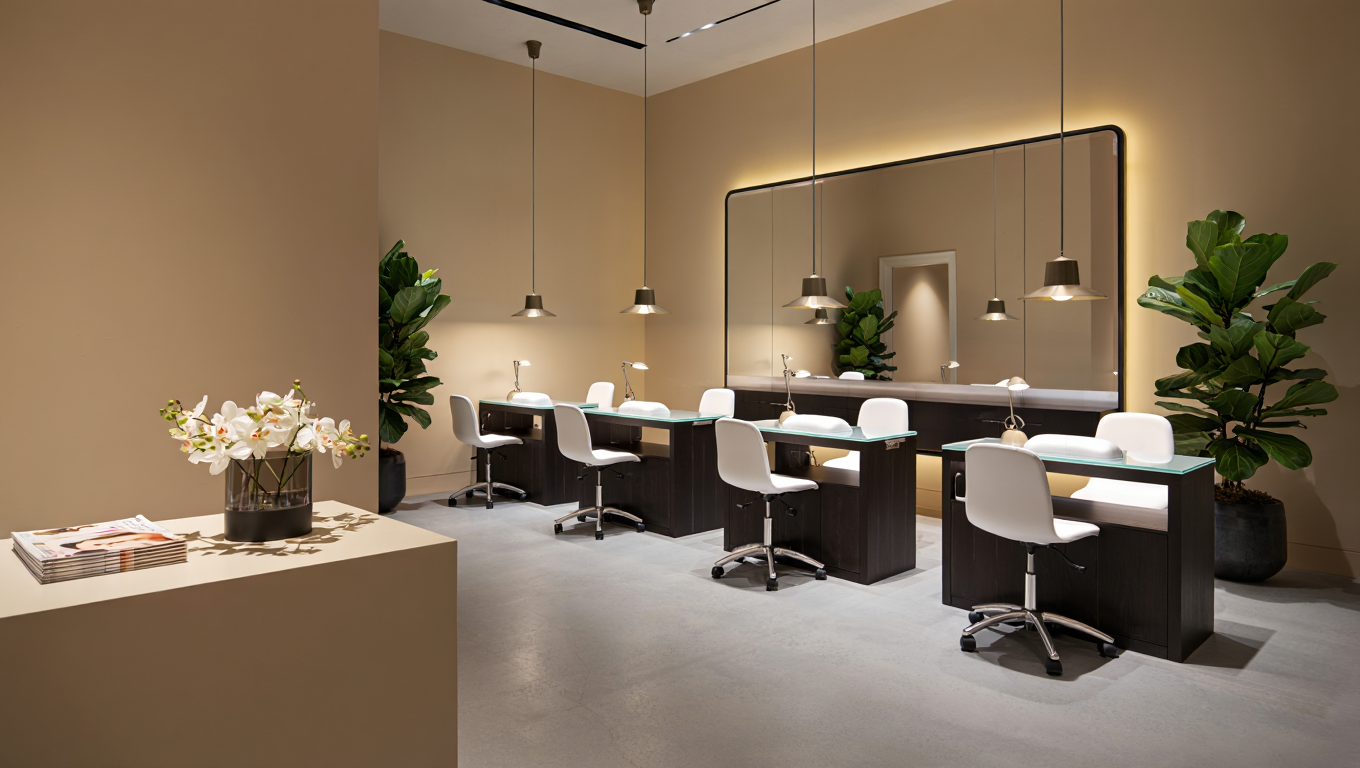Chicago salon owners wrestle with one persistent problem. Customers judge the space before they judge the manicure. That snap impression can help or hurt sales. Smart owners turn the room into a silent salesperson. They lean on nail salon design tips that shape flow, comfort, and brand feel. In this article, that phrase means practical, repeatable methods owners can use to plan rooms, choose materials, light stations, and stage decor for repeat visits and higher ticket sizes. Expect clear moves, flexible playbooks, and city-ready examples that handle lakefront winters, foot traffic, and dense neighborhoods. Use this guide start to finish; at the end, you can download a printable A4 checklist to put today’s plans into action.
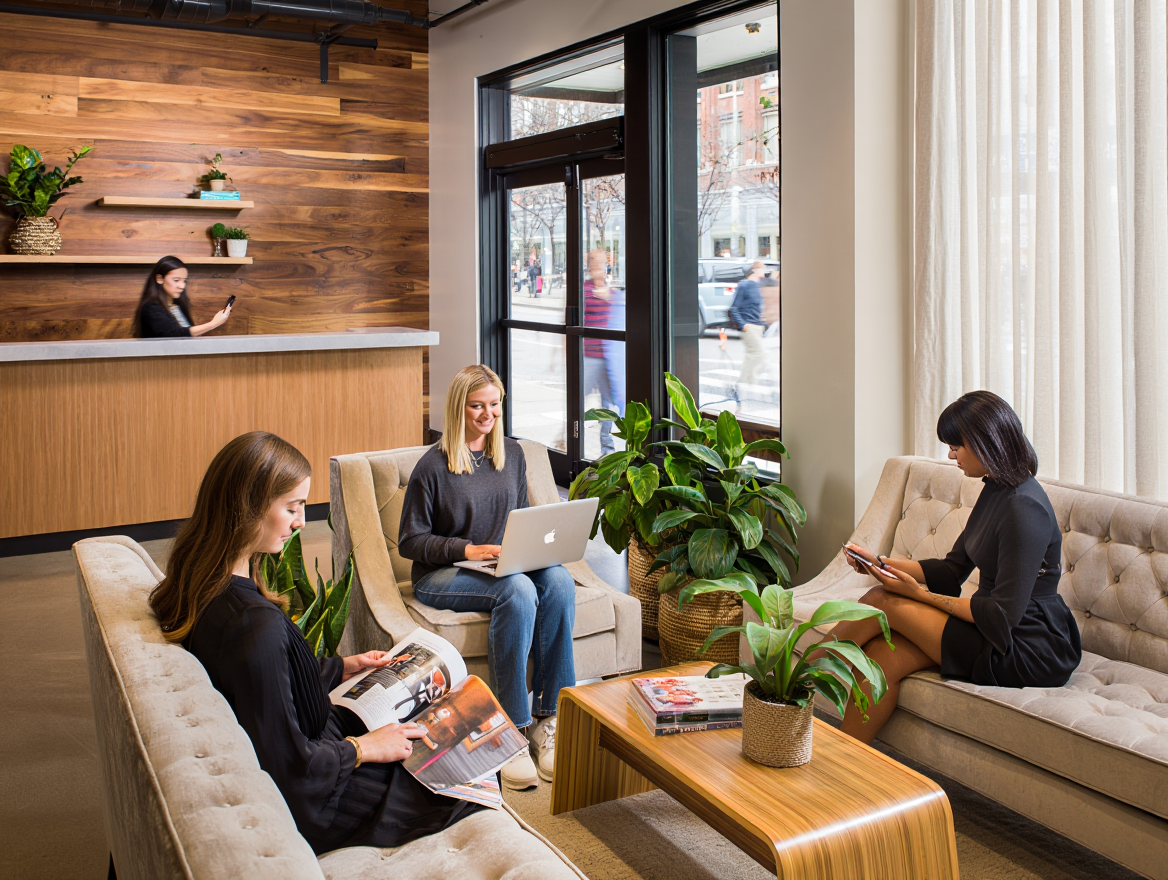
Importance of ambiance in salon experience
A strong atmosphere calms clients and steadies staff. A consistent mood cues quality and care. People relax faster, spend longer, and say yes to add-ons. Good rooms guide eyes, reduce stress, and earn trust. Owners who prioritize nail salon interior ideas align sound, scent, and temperature to the service journey. The result feels effortless and memorable.
Colors & materials
Color, texture, and finish set the emotional baseline. Warm woods and matte paint soften city edges. Durable quartz and sealed grout handle winter boots and salt. Acoustic panels hush trains and hallway chatter. Small Chicago spaces benefit from pale walls with darker trim for definition without clutter.
- Use three tones max per zone to keep focus on nails.
- Repeat textures across furniture and shelving to create rhythm.
- Balance matte walls with subtle sheen on tables for easy wipe-downs.
- Add plant life that tolerates low light and radiators.
Box out a clear palette per zone and reuse it at least three times before introducing anything new.
Clients notice balance more than they notice brand names. Repetition builds rhythm and reduces visual fatigue. A unified scheme makes add-on displays feel curated, not crowded. Strategic restraint keeps the eye on hands, not wall noise.
Owners often ask whether statement walls still work. They do, but they must serve circulation and sightlines, not compete with stations. One textured wall behind retail can pull shoppers forward. Another near reception can anchor a photo moment without stealing task light.
Real-world evidence helps. A University of Toronto study found bright environments heighten emotional intensity, which can amplify both delight and irritation; careful control avoids sensory overload during decisions like upgrades (2014, Toronto).
Place the first instance of soft ambient lighting away from mirrors that cause glare. Keep a soft gradient from reception to chairs. Customers should enter through calm, not spotlight.
Conclude this section with a simple point. A disciplined palette and thoughtful surfaces make small city rooms feel bigger, cleaner, and more premium.
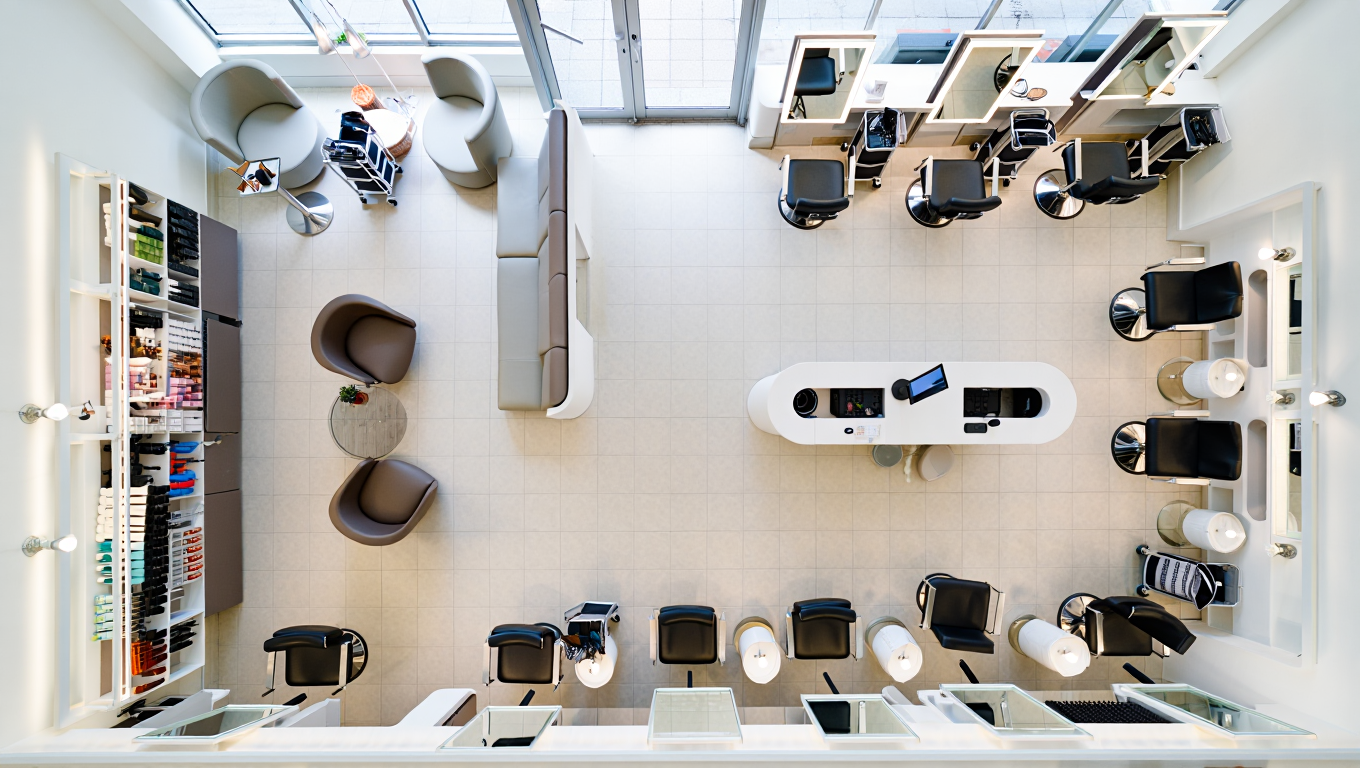
Layout & flow tips
Strong flow moves people without friction. Reception should face the door, not block it. Retail should sit on the path to seating, never hidden in a corner. Polish walls need breathing room so colors look true. A plan that respects steps, sightlines, and sound earns five extra minutes per client, which often equals an add-on.
nail salon design tips shine here when owners map zones like a loop. Avoid dead ends where guests bunch up. Keep staff routes short and straight. Push storage vertical to free floor area.
Task + ambient lighting
Before light fixtures, lock the path. Bright work at tables, softer glow for waiting, and a warmer wash for retail. The eyes should not fight between zones. Mount dimmable sources so staff can tune levels by time of day.
Owners love tables, but aisles carry the day. Follow a clean metric for Chicago’s narrow footprints. Keep at least 42 inches for any main aisle. Leave 30 inches between chairs for privacy and movement. Turn corners with rounded edges to save shins and bags.
Table: Sample circulation standards for compact salons
| Zone | Minimum clear width | Purpose | Notes |
|---|---|---|---|
| Entry to desk | 48 in | Avoid door jams | Add mat for snow |
| Main aisle | 42 in | Two-way passing | Works with carts |
| Between stations | 30 in | Elbow room | Reduces bumping |
| Backroom path | 36 in | Supply runs | Keep unlocked |
| ADA turning circle | 60 in | Accessibility | Keep free of racks |
A common question pops up about tight retail corners. Angle shelves slightly toward the aisle to improve visibility, and keep highest sellers at eye level. Use small ledges, not deep cubes, so inventory looks tidy. That tweak lifts impulse picks without adding clutter.
Research backs ergonomic planning in salons. NIOSH evaluated nail salons and documented musculoskeletal strain, recommending better ergonomics and ventilation (2019, Cincinnati).
Place decor tips nail studio away from busy paths to reduce snag points. Mount art at 57 inches on center for a calm horizon line. That height reads well for seated and standing guests.
A short wrap here works. Smooth flow plus tuned lighting reduces stress, raises capacity, and keeps retail in play. New plans benefit from one more reminder. Use nail salon design tips to stage the service loop so guests never cross back through prep. That single move trims confusion and protects privacy.
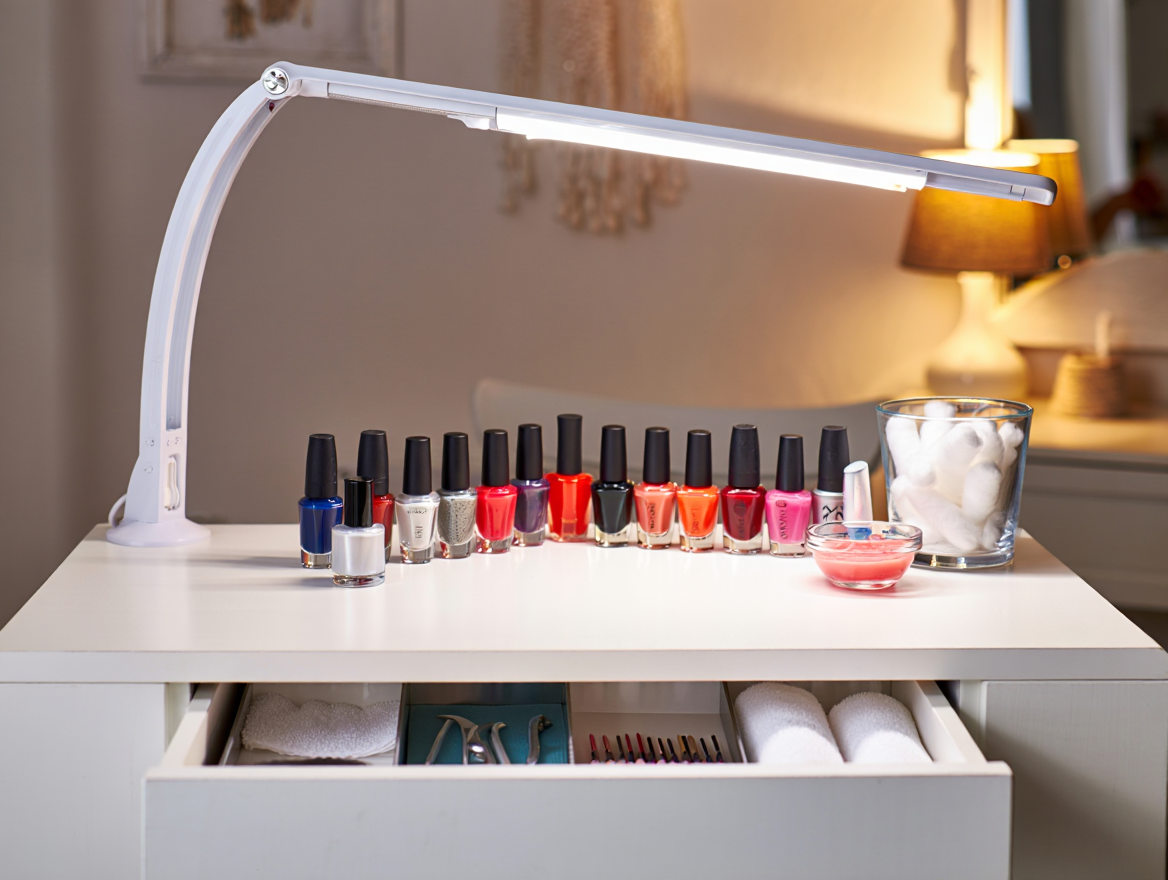
Lighting design for nails & ambiance
Light is the unsung profit driver. Nails need accurate color and crisp edges. Faces need flattering warmth. The room needs rhythm across morning shadows and evening rush. Owners who plan layered nail salon interior ideas for illumination reduce eye strain and speed complex sets.
A well-balanced plan usually mixes downlights, pendants, and task lamps. Ceiling light sets general tone. Pendants give scale and shape. Task sources deliver precision at the plate.
Task + ambient lighting
Task light should hit the nail at a steep angle to avoid shadows from hands. A high CRI keeps reds, nudes, and glitter true. Dimmers let staff drop brightness during soak-offs and waiting periods. The ambient layer fills corners so photos come out clean without harsh edits.
- Start with 3000–3500K ambient for warmth that flatters skin.
- Add 4000–5000K task lamps with high CRI for color accuracy.
- Use diffusers on overheads to cut glare on glossy polish.
- Put retail under spot accents to spark interest without heat.
Evidence matters here too. Controlled studies show lighting changes shape consumer emotions and choices; bright settings intensify reactions, so tuning levels helps steer experience (2014, Toronto).
“Lighting is everything. It is one of the most dynamic and essential tools in interior design. It should never be an afterthought.” — Kelly Hoppen, CBE, interior designer.
Chicago winters bring early dusk. Timer scenes bridge day to night smoothly. Morning can run cooler for alert energy. Late afternoon warms up to relax after commuters step off the Brown Line. Install a small sensor by the front window to auto-nudge scenes when clouds roll in from the lake.
Owners often ask if ring lights are enough. They help for photos, but they cannot replace well-aimed task lamps. Rings flatten the nail surface and mislead on color. Customers buy with their eyes, then leave reviews with their phones. Get it right at the table first. See our nail shape guide for choosing shapes by hand proportions.
Use salon ambiance lighting to guide service steps. Raise levels for prep and shaping. Ease down for massage and polish cure waiting. The body reads the cues and unwinds faster.
Wrap this section with one truth. Layers, not single sources, build comfort and precision in a compact floor plan.
A final tip for this chapter closes the loop. Among nail salon design tips, prebuilt scene presets shorten training and protect photo quality during rush hours. New hires learn faster, and returning guests enjoy steady results week after week.
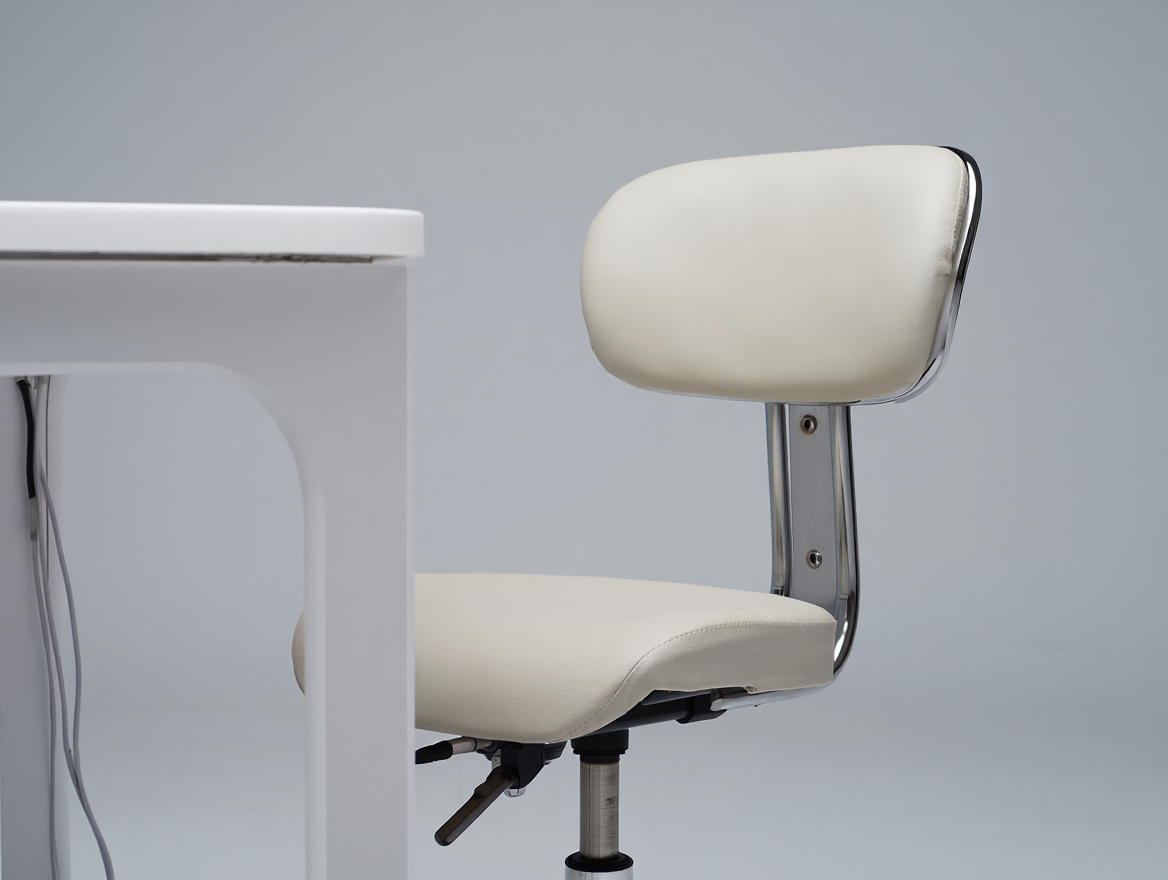
Furniture & chairs styles
Chairs and tables do the heavy lifting all day. Support, wipeability, and scale matter more than trend. Thin legs make rooms look airy, yet frames must hold steady for filing torque. Tables should hide cords and allow local capture for fumes.
Well-chosen seating follows nail salon design tips that blend ergonomics and durability. Keep lumbar support for long sets. Choose fabrics with commercial rub counts. Test edge softness so forearms do not bruise. Add footrests to reduce back strain.
A frequent question concerns velvet or boucle. They look rich but demand strict care. In winter, wet coats and salt will shorten life. Use faux leather with stitched panels for texture instead. Swap cushions seasonally to refresh without reupholstery.
Safety data supports ergonomic investment. Studies find higher rates of neck and shoulder pain among technicians; better posture and station setup reduce risk (2011, UK).
Place decor tips nail studio in furniture lines, not only on walls. Cane backs, fluted fronts, or ribbed upholstery create subtle movement. That detail reads premium and photographs well for social feeds.
Choose furniture that protects posture first, then layer style. Comfort fuels speed, and speed fuels profit.
End this section with a checklist mindset. If a chair saves one break a day, it pays for itself within a season.
One more point helps with durability. Current nail salon design tips favor hidden power channels and inset grommets that keep cords tidy under hard use. That detail protects floors and prevents mid-service tangles without visual clutter.
Branding elements & decor
Brand lives in more than a logo. It shows up in tone, rhythm, and scent. A Chicago brand might nod to lake blues, vintage tile, or warehouse textures. Consistency across cards, menus, and walls helps recall and referrals.
Strong identity uses nail salon interior ideas that translate into repeatable parts. Think ribbon colors, tray materials, and a signature stem in small vases. Pick one motif and echo it across rooms. The eye finds comfort in recognizable beats.
Owners often ask how to push personality without mess. Build a tight “kit of parts.” Limit shelf props. Keep dust-friendly items behind glass. Use vertical stripes or thin slats to stretch height in low ceilings.
“Ultimately design is a tool to enhance our humanity. It is a frame for life.” — Ilse Crawford, designer and author.
Strategic salon ambiance lighting helps the brand read true in photos. Warmer retail accents flatter packaging. Cool task light keeps nail art accurate. A neutral background lets color stories stand out online.
Owners can boost retail by staging a small “Chicago edit.” Rotate three hero products each month. Add a simple card with routine steps. Keep this island near the exit so customers see it twice. Close this chapter on a simple lesson. Aim for a room where every small detail whispers the same story.
A short add-on brings identity back to tactics. Post small placards with nail salon design tips near the staff area to lock voice and visuals. That shared language keeps the brand steady during busy weekends and new staff onboarding.
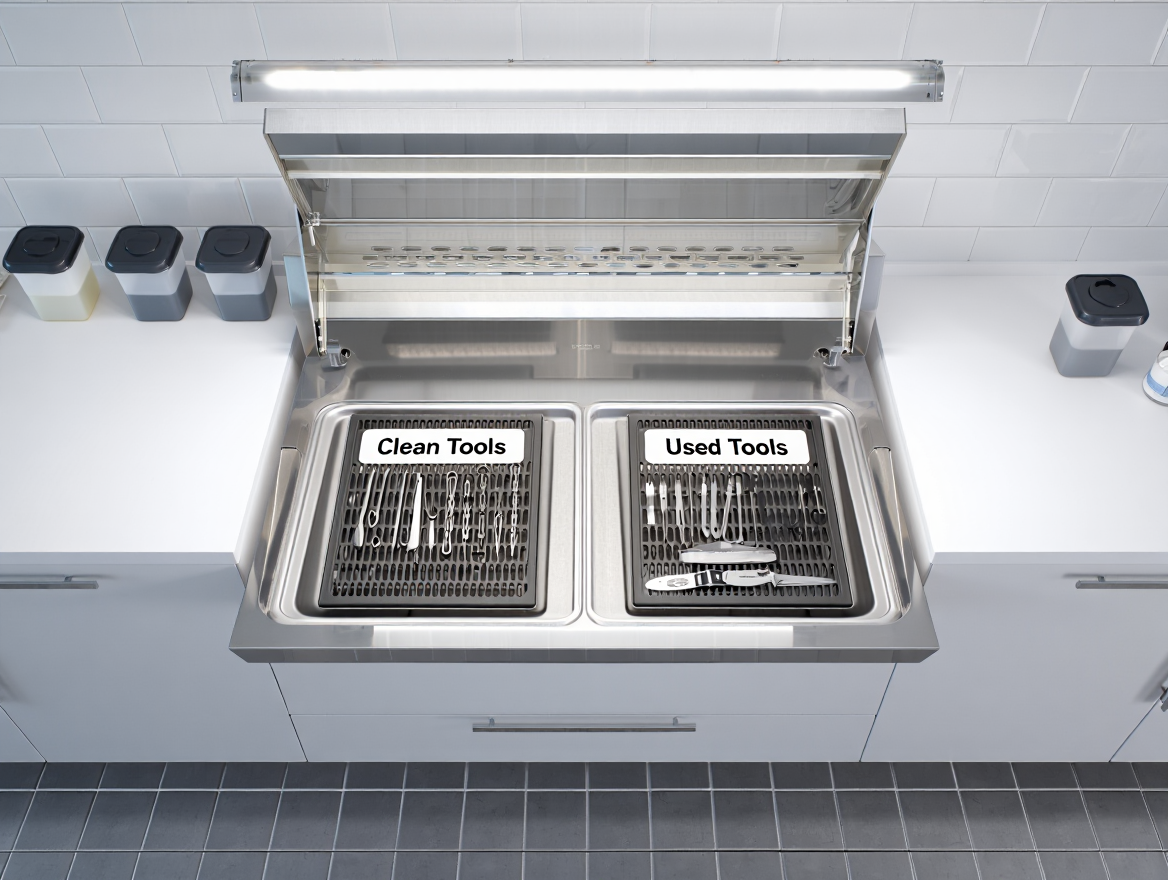
Safety & sanitation integration
Clean practices should feel natural, not clinical. Integrate hygiene into millwork so guests see care without harsh signals. Closed bins near every station reduce carrying. Hands-free pumps and foot-pedal cans speed workflow.
Build nail salon design tips into sanitation from day one. Store disinfectants at arm level, not high shelves. Label drawers with icons, not tiny words. Use color code trays for clean versus used tools. Place washable mats under rolling stools to catch dust.
Owners ask whether visible disinfecting scares clients. It does not when done calmly and consistently. A short script helps: “We reset each station between guests.” Post a simple placard near reception that lists the three hygiene steps.
Guidance is clear on ventilation and health. OSHA and NIOSH recommend local exhaust and good general airflow in nail salons to limit chemical exposure and support worker health (2012–2019, USA).
Place salon ambiance lighting so staff can see dust and finish flaws without harsh glare. Good light supports quality and sanitation checks in one shot.
Treat ventilation as a design feature. Downdraft tables and quiet fans belong in the concept board, not only the spec sheet.
Finish on this point. When cleanliness looks effortless, customers relax and return. One last addition turns policy into practice. Practical nail salon design tips tie cleaning to motion with labeled drop zones and short routes. Staff waste fewer steps, and tools return home without reminders.
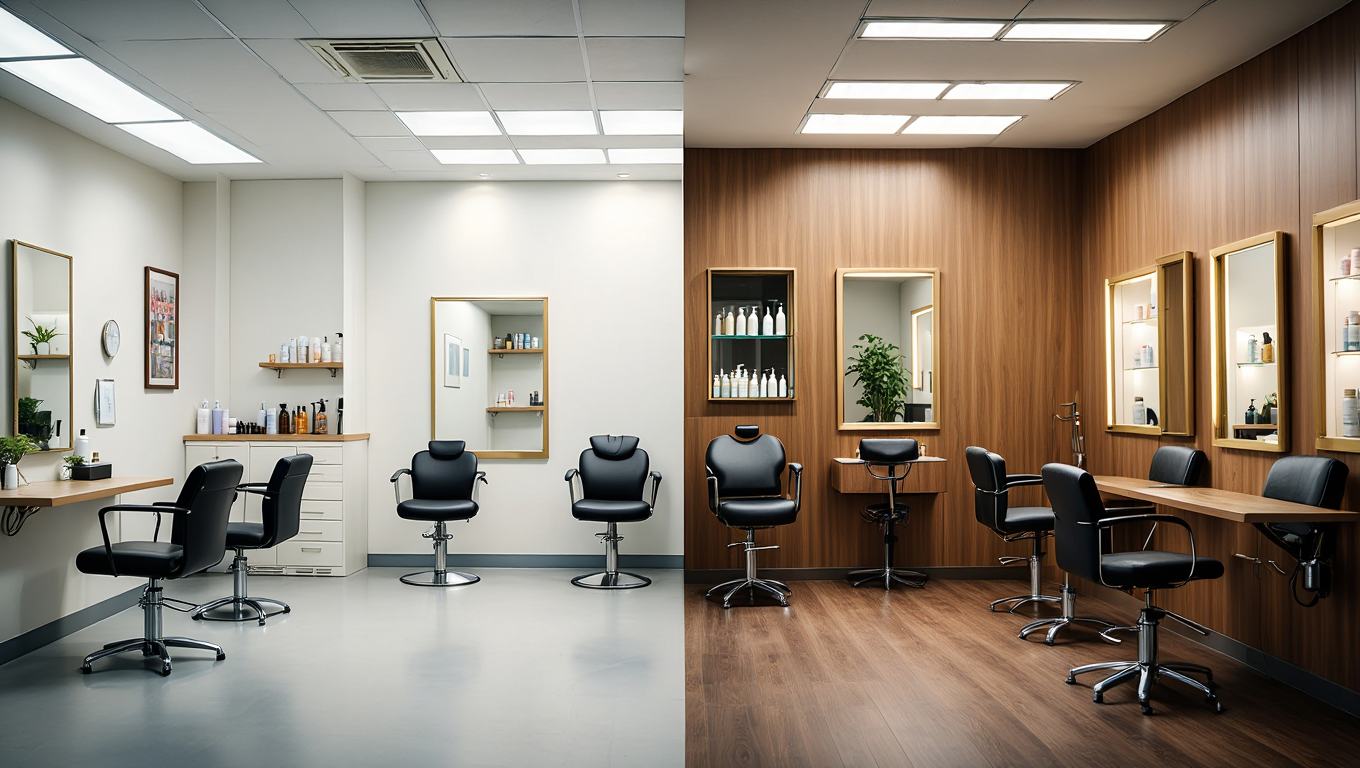
Budget vs luxury design
Money choices shape the room more than style boards do. Spend where hands touch and eyes linger. Save on the things that do not move the guest or the workflow. A sharp plan raises perceived quality at every price tier.
Owners who follow nail salon design tips spend on chairs, task lamps, and storage first. They stretch dollars by painting existing millwork and swapping hardware. They phase flooring by zone. They choose neutral core materials, then refresh soft goods with seasonal color.
A common question asks where to splurge. Lighting scenes, noise control, and ventilation pay off. These pieces improve comfort, speed, and staff health. Decorative layers can wait. Start lean, then add art and soft seating once revenue stabilizes.
Public programs show the path. Healthy Nail Salon guidelines from California outline safer product choices and ventilation best practices that any state can adapt (2018, California).
Use decor tips nail studio to add character without big checks. Swap vase stems, rotate books, and use framed prints from local artists. Tie the art to Chicago neighborhoods for story and loyalty.
“Design is how it works.” — Steve Jobs, on function leading form.
Wrap with one takeaway. Invest in parts that improve service quality daily, then layer personality with low-risk swaps.
Here is one more budget guardrail that pays off. Follow nail salon design tips that prioritize replaceable parts and standardized bulbs across fixtures. Maintenance stays simple, and downtime drops during peak seasons.
FAQ
How do you pick colors that flatter every skin tone without washing out nail shades?
Choose warm-neutral walls and reserve cool notes for task lighting. Keep high-CRI task lamps at stations for accurate color while the room glows warm. This combo supports nail salon design tips that center hands and faces.
Why does layered lighting matter more than one bright fixture?
Layering separates work from mood. It reduces glare, controls reflections, and steers emotions during choices and checkouts. Studies show brightness can heighten feelings, so scenes guide experience.
What’s better for tight spaces: row stations or islands?
Rows along walls usually win. They protect aisles and shorten cable runs. Islands can work in wide spaces but require more airflow planning and cord management.
How should ventilation be sized for small salons?
Start with local capture at each table and balanced general airflow. Follow manufacturer specs and verify with simple smoke tests. Agencies recommend local exhaust to cut exposures in salons.
How can a brand show up without over-decorating?
Use a kit of parts: one motif, one accent color, and a consistent material. Repeat them across trays, menus, and shelves. Keep extras behind glass to reduce dust.
In this video, viewers see how Chicago nail salon owners can enhance even the smallest space with clever design, smart lighting, and repeatable ambiance tips. It demonstrates practical, budget-friendly decor decisions and efficient furniture layout that increase flow, comfort, and professional appeal — exactly matching this article’s main topic. Watch to experience successful ambiance upgrades in real time.
Conclusion
Chicago salons thrive when rooms work as hard as artists. Flow cuts delays. Layers of light make color true and skin warm. Furniture protects bodies and speeds precision. Branding repeats in quiet details. Ventilation lives in the concept, not just the permit set. Owners who apply nail salon design tips consistently see steadier staff, calmer guests, and stronger reviews. Start with a tight loop, honest scenes, ergonomic seating, and visible hygiene. Then layer personality that fits the neighborhood and season. Book a planning day this week, set your scenes, and align the floor to the service you want to sell next quarter.
You made it to the end. To turn ideas into results, grab the A4 checklist below. It organizes scenes, flow, sanitation, and brand tasks into quick daily and weekly moves, so your team can act without meetings or guesswork.
